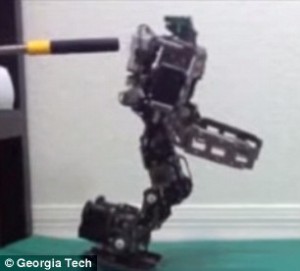Researchers at Georgia Tech have identified a way to teach robots how to fall with grace and without serious damage. The work is important as costly robots become more common in manufacturing alongside humans. The skill becomes especially important, too, as robots are sought for health care or domestic tasks working near the elderly, injured, children or pets. These machines are expensive to make and typically take months, if not years, to complete meaning every time they fall they can become damaged or faulty.
To help such robots fall more gracefully, and reduce this damage, roboticists have developed an algorithm to manage their movements and they test it by pushing the robots over, again and again. The algorithm was developed at Georgia Tech by PhD graduate Sehoon Ha and Professor Karen Liu. Specifically, this algorithm tells a robot how to react to a variety of falls, from a stumble while taking a single step, to recovering from a gentle nudge and rolling to break a high-speed fall. This helps the robots minimize the damage or injury they might cause to themselves or others while falling by learning the best sequence of movements to slow their momentum.
The planning algorithm was validated in physics simulation and tested on a BioloidGP humanoid. This involved pushing a robot that hadn’t been trained using the algorithm, and one that had been, with ever-increasing force. ‘A fall can potentially cause detrimental damage to the robot and enormous cost to repair,’ said Ha, who graduated in summer 2015 and is now a postdoctoral associate at Disney Research Pittsburgh in Pennsylvania. ‘We believe robots can learn how to fall safely. ‘Our work unified existing research about how to teach robots to fall by giving them a tool to automatically determine the total number of contacts, how many hands shoved it, for example , the order of contacts, and the position and timing of those contacts. ‘All of that impacts the potential of a fall and changes the robot’s response.’
With the latest finding, Ha builds upon Professor Liu’s previous research that studied how cats modify their bodies during a fall. This work revealed that one of the most important factors in a fall is the angle of the landing. She also discovered that a well-designed robot has the ‘brain’ to compute a softer landing, but hadn’t yet optimized the sequence of motions that take place during a fall. ‘From previous work, we knew a robot had the computational know-how to achieve a softer landing, but it didn’t have the hardware to move quickly enough like a cat,’ Professor Liu said.
‘Our new planning algorithm takes into account the hardware constraints and the capabilities of the robot, and suggests a sequence of contacts so the robot gradually can slow itself down.”Now the robots may fall more gracefully than people and possibly cats, too. Imagine that.’
For more information please visit: www.dailymail.co.uk

